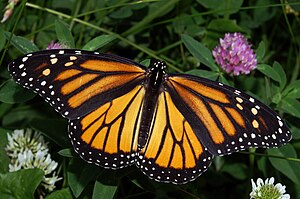 |
| Monarch Butterfly (Photo credit: Wikipedia) |
Some years ago I became aware of the plight of the Monarch butterfly (Danaus plexippus).
With its habitat being destroyed at an alarming rate, this beautiful pollinator is in peril in North America.
As a butterfly lover, I certainly wanted to help if at all possible.
I found out what is involved in creating Monarch habitats and established my own Monarch Waystation. It was easy to do, it was enjoyable, and the rewards were almost immediate.
Even when the number of Monarchs visiting my station is sparse, numerous other butterfly species come in abundance to enjoy the nectar sources.
Along with habitat destruction, the fact that this species of butterfly is the only one known to make a two-way migration may make waystations crucial to the survival of the Monarch.
Unable to tolerate cold weather or overwinter as larvae or pupae, Monarchs use cues from the environment to know when it is time for their unique migration. This migration can take them as far as 3000 miles and may take up to two months to complete.
Monarchs in eastern North America migrate to the Sierra Madre Mountains of Mexico or to Florida. Monarchs in western North America overwinter primarily in California.
In addition, waystations are necessary because the only source of food for Monarch caterpillars is milkweed plants. It is essential to include native milkweeds in any Monarch Waystation.
A Monarch Waystation can be small or large. It isn't the amount of planting space that makes a successful waystation but rather the types of plants found there. Colorful flowers are important for attracting Monarchs because butterflies are known to possess good color vision.
They can sense more colors than either bees or humans and can even see the color red. In addition to including native milkweeds, waystations may contain any of a number of plants of your choice that serve as nectar sources for the Monarchs.
The overwhelming majority of plants in my Monarch Waystation are natives and include Asclepias curassivica, Asclepias incarnata, Asclepias viridis, Asclepias verticillata, monardas, Gonolobus suberosus (Angelpod, a native vine related to milkweed), phlox, liatris, buddlejas, salvias, eupatoriums (Joe Pye Weed), nepetas, coreopsis, goldenrod, purple coneflowers, sedums, violas, asters, and marigolds.
Water sources are also necessary for butterflies to thrive. While a natural diet is always best, Monarchs can be lured closer to a deck, patio, or porch for observation by providing a source of artificial nectar.
Rather than using sugar, make this nectar with a heaping teaspoon of honey (preferably raw) dissolved in half a glass of water, with a drop of soy sauce or liquid amino acids added to provide additional minerals. Saturate a tissue or paper towel with the solution and place in a shallow dish.
Sliced fresh fruits like watermelon, apples, oranges, and bananas are also relished by Monarchs.
Feeding, observing, and even raising Monarchs can be an educational and rewarding experience for children and adults alike. It doesn't require a lot of space or expense.
Kits designed for farming Monarchs are available or can be made at home fairly easily. In just 25 to 32 days, you can raise and release some of these beauties into a waystation yourself.
For further information about Monarch Waystations and Monarch butterflies: http://monarchwatch.org/ and http://www.defenders.org/monarch-butterfly/basic-facts
Article Source: http://EzineArticles.com/?expert=C_Tee_Menser
http://EzineArticles.com/?Monarch-Butterfly-Waystations&id=7988221

No comments:
Post a Comment